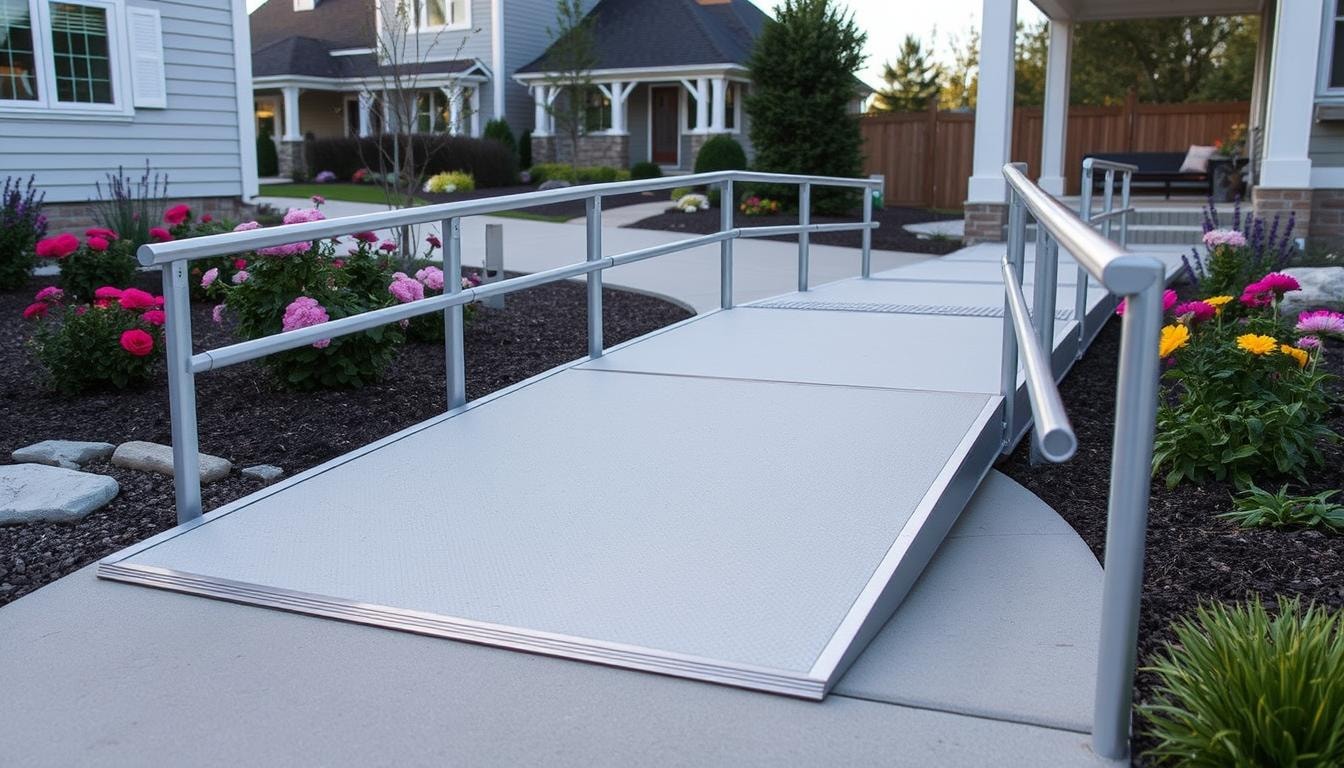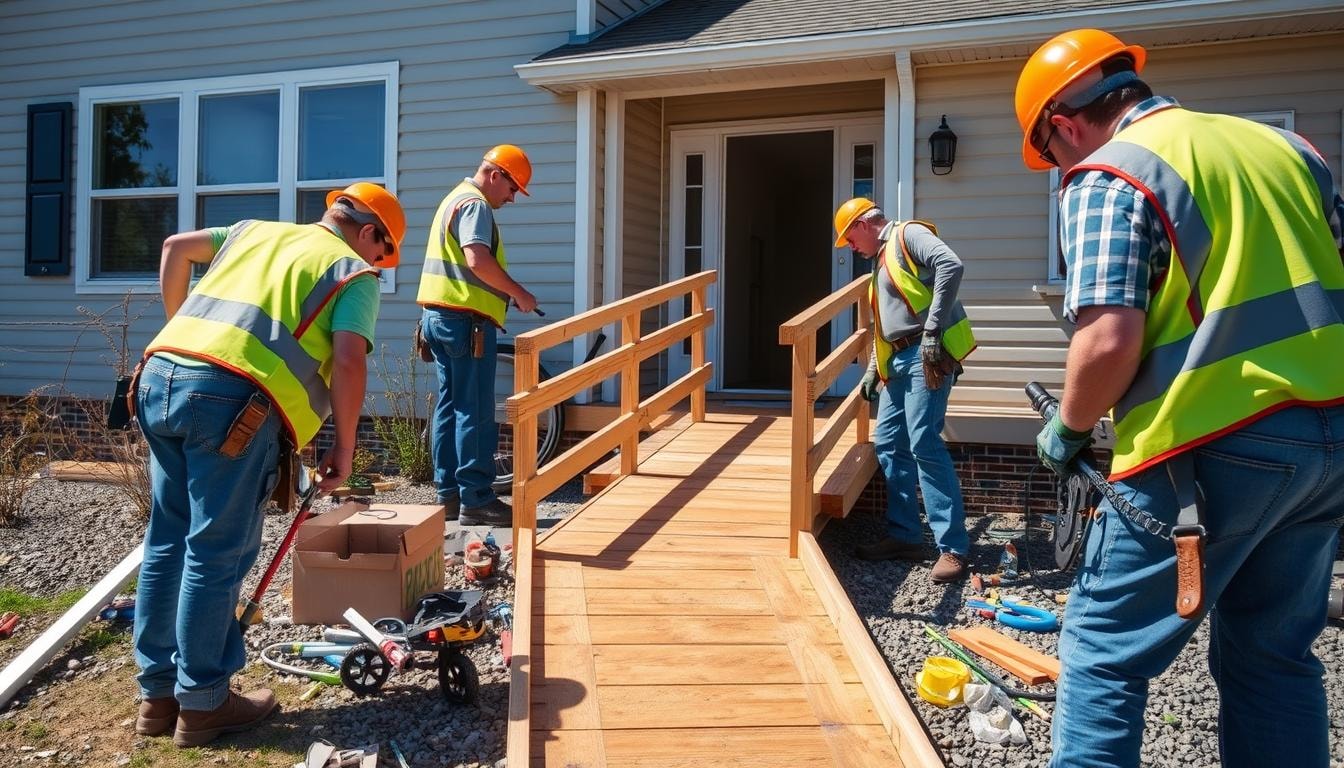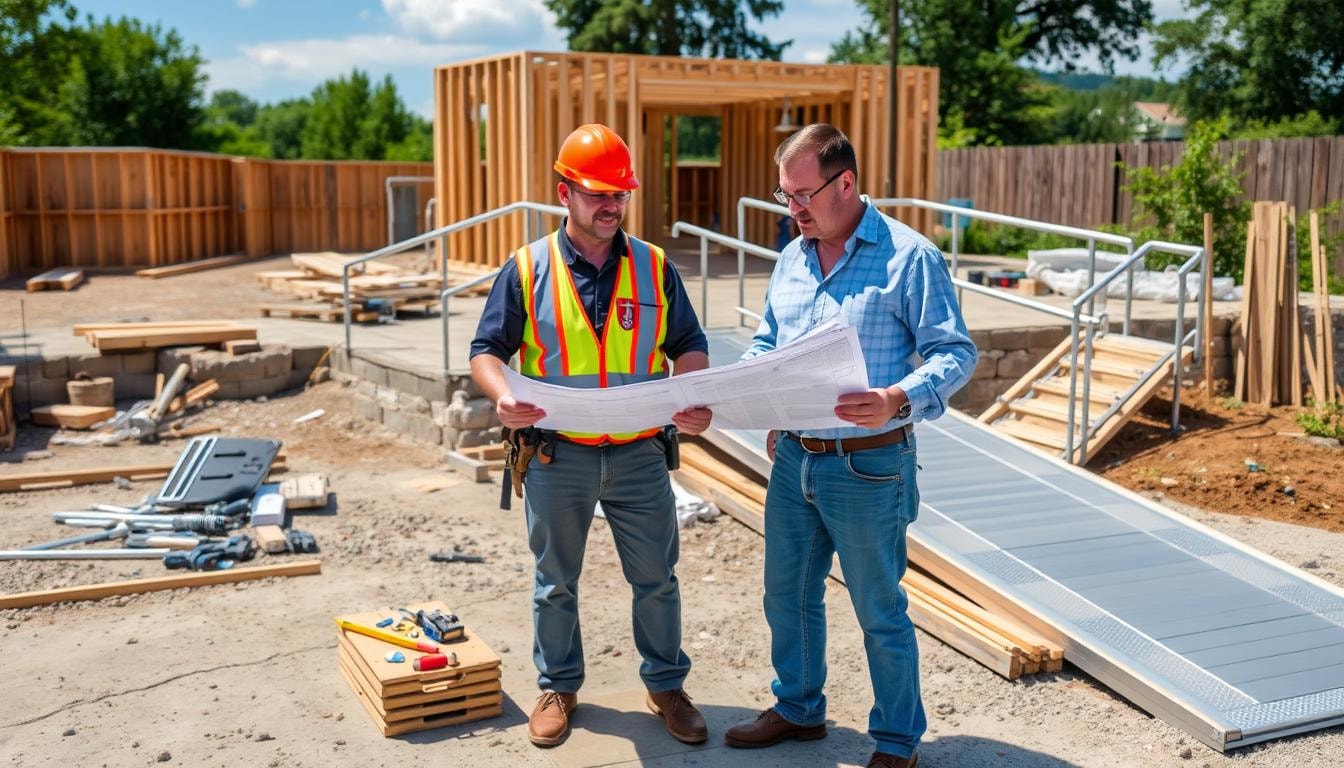Wheelchair Ramp Builders Near You
Can’t find what you are looking for?
How It Works
-
Answer a few questions about your home project.
-
Within seconds, get matched with top-rated local pros.
-
Compare quotes and choose the best pro for the job.
Wheelchair Ramp Builders In Your Area
Wheelchair Ramp Builders: A Guide to Hiring the Right Contractor

Key Takeaways
- Wheelchair ramps are becoming more popular and affordable as the American population ages.
- A wheelchair ramp can provide a convenient way to access your home and allow you to remain independent.
- Hiring the right contractor is crucial for a successful wheelchair ramp installation project.
- Verifying the contractor’s licenses, insurance, and experience is essential to ensure a quality and safe installation.
- Obtaining multiple bids and understanding the contract details are important steps in the hiring process.
Understanding the Need for Wheelchair Ramps
Stairs and uneven entryways can be tricky for people with mobility issues. Wheelchair ramps are key to safe access for homes and public buildings. They help those using wheelchairs, walkers, or canes.
Defining the Barrier: Rise and ADA Ramp Slope
“Rise” is the height of steps or thresholds that block people with mobility issues. ADA-compliant ramps need a 1:12 slope ratio. This means 12 inches of ramp for every 1 inch of rise.
This gentle slope makes ramps comfy for users. It also cuts down on falls and injuries.
Common Situations Requiring Wheelchair Ramps
Wheelchair ramps are often needed in these cases:
- Homes with steps or high doorways that block accessibility for people with disabilities or mobility issues
- Temporary mobility needs due to injuries or health issues requiring a wheelchair or walker
- Public buildings and commercial spaces that need to welcome visitors with disabilities
Knowing about wheelchair ramps helps owners improve accessibility. This makes spaces safer for those with mobility challenges. It’s a vital step towards inclusive design.
Types of Wheelchair Ramps
Wheelchair ramps are crucial for improving accessibility. Various ramp types are available, each with unique features and benefits. Your choice depends on your needs, budget, and home layout.
Modular Aluminum Wheelchair Ramps
Modular aluminum ramps offer customizable solutions for specific requirements. They’re quick to install and have high weight capacity. These ramps are durable, lightweight, and need little maintenance.
Threshold Ramps
Threshold ramps bridge small gaps at doorways for smooth wheelchair transitions. They’re compact and cost-effective for minor accessibility issues. These portable ramps work well for temporary use.
Portable and Folding Ramps
Portable and folding ramps are great for temporary or occasional use. They’re easy to transport and set up. These versatile ramps can overcome 1-2 steps in various settings.
Wood Wheelchair Ramps
Wooden ramps can be custom-built on-site and look appealing. However, they need more upkeep than aluminum or concrete options. Wood ramps may weather and degrade over time.
Concrete Wheelchair Ramps
Concrete ramps offer permanent, non-slip solutions that blend with surrounding architecture. They’re custom-built and more expensive but provide lasting accessibility. These ramps are visually appealing and durable.
Consider materials, features, design, and safety when choosing a wheelchair ramp. Factor in ADA compliance, weight capacity, and maintenance needs. Understanding each ramp type helps you make an informed decision.
Wheelchair Ramp Installation Options and Timeframes
Installing a wheelchair ramp offers various options and timeframes. Modular aluminum ramps are quick, often installed in one day. Custom wood or concrete ramps may take days or weeks to build.
Discuss installation timelines with potential contractors before starting your project. This helps you plan for any temporary disruptions. You can then choose the best ramp solution for your home.
Installation Timelines and Costs
Wheelchair ramp costs and installation times vary based on the type of ramp:
- Modular aluminum ramps: Installation typically takes less than a day, with labor costs ranging from $60 to $100 per linear foot. The total cost, including materials, can range from $150 to $200 per linear foot.
- Steel wheelchair ramps: Installation can take up to a few days, with labor costs between $60 and $100 per linear foot. The total cost, including materials, ranges from $200 to $250 per linear foot.
- Wooden wheelchair ramps: Installation can take several days, with material costs ranging from $100 to $250 per linear foot and labor charges varying based on the complexity of the project.
- Concrete ramps: Construction can take multiple weeks, with a total cost estimate of $250 to $350 per linear foot for a 36-inch-wide ramp.
- Portable and threshold ramps: These options can be installed in a matter of minutes, with prices ranging from $35 to $600 depending on the size and material.
Building permit costs can add $150 to $1,500 to your project budget. Local regulations and project scope affect these costs. Wheelchair ramp builders can help streamline installation and ensure accessibility standards are met.
Benefits of Wheelchair Ramps
Wheelchair ramps offer many perks for people with mobility challenges. These structures allow safe and independent home access. They prevent falls and injuries from steps or uneven surfaces.
Ramps boost independence and life quality for users. They help people join daily activities and keep social connections. Users can stay in their beloved homes instead of moving to assisted living.
This keeps their sense of freedom intact. It lets them age in place with familiar surroundings. Ramps also make homes safer by reducing fall risks.
- Improved accessibility and mobility for individuals with disabilities or mobility challenges
- Increased independence and ability to participate in daily activities
- Reduced risk of falls and injuries from navigating steps or uneven surfaces
- Ability to remain in the comfort of one’s own home and age in place
- Potential to increase the value and marketability of a residential property
Wheelchair ramps ensure better access, safety, and freedom. They empower users to live fuller lives. This investment helps both users and the community.
It makes neighborhoods more inclusive and accessible for everyone. Ramps create a welcoming environment for all residents.
Wheelchair Ramp Builders: Hiring the Right Contractor

Choosing the right wheelchair ramp builder is vital for accessibility and home modifications. Specialized expertise, proper licensing, and insurance are essential for safe, compliant projects. Let’s explore key factors to guide your decision.
Define Your Project Requirements
Clearly outline your wheelchair ramp project’s scope. Decide on dimensions, materials, and features that best suit your needs. Consider rise, slope, and accessibility to meet ADA standards and local building codes.
Seek Recommendations and References
Ask friends, family, and local organizations for reputable wheelchair ramp builder recommendations. Request references from past clients to assess reliability and craftsmanship. This will help you find a contractor with a proven track record.
Verify Licenses and Insurance
Ensure your chosen wheelchair ramp builder is licensed, bonded, and insured. Ask for copies of licenses, permits, and insurance certificates. This protects you and your home from potential liabilities during construction.
Conducting Contractor Interviews
Finding the right wheelchair ramp contractor is key for your home project. Assess their experience, skills, and how well they communicate. Thorough interviews help you pick a qualified and professional contractor.
Assessing Experience and Expertise
Ask about the contractor’s past wheelchair ramp installations. Check their training, certifications, and team size. Good contractors know accessibility rules, disability needs, and senior living standards.
Communication and Professionalism
- Pay close attention to the contractor’s communication style and level of professionalism during the interview process.
- A reliable wheelchair ramp contractor should demonstrate active listening skills, responsiveness, and a genuine willingness to address your concerns throughout the project.
- Effective communication and a professional demeanor are essential for a smooth collaboration and a successful home modifications outcome.
Careful vetting helps you choose a contractor with the right skills. Look for expertise, good communication, and professionalism. This ensures you’ll get a top-quality wheelchair ramp that meets your needs.
Obtaining and Comparing Bids

Getting bids from multiple wheelchair ramp contractors is key. This helps you find the best value and a qualified team. Reach out to at least three contractors for detailed bids.
Each proposal should break down costs for materials and labor. It should also include a timeline for completion. Be wary of very low estimates, as they may hide issues.
High bids don’t always mean better quality. Look for fair, transparent quotes that match your project’s scope. Consider factors beyond just the price when comparing bids.
Evaluate contractors’ reputations and experience. A slightly higher bid from a trusted company may be worth it. Balance cost, quality, and expertise to make a smart choice.
- Obtain detailed bids from at least three different wheelchair ramp contractors.
- Ensure the bids include a breakdown of costs for materials, labor, and a projected timeline.
- Beware of significantly low bids, as they may indicate low-quality work or hidden costs.
- Compare the bids carefully, considering the contractor’s reputation, experience, and the overall value they offer.
Taking time to compare bids helps you make a smart choice. You’ll find a contractor who fits your needs, budget, and project goals.
Budgeting for Your Wheelchair Ramp Project
Budgeting is key when planning your wheelchair ramp project. Be realistic about your finances and explore low-cost options. Materials, labor, and customizations can greatly impact overall expenses.
Considering Low-Cost Alternatives
If estimates exceed your budget, talk to your contractor about options. Look into affordable ramp materials like modular aluminum or threshold ramps. These can provide durable and cost-effective solutions for your accessibility needs.
Scaling Back or Phasing the Project
- Consider reducing the ramp’s size or length to focus on critical accessibility needs first.
- Think about completing the project in phases, starting with high-priority areas.
- Prioritize essential modifications that will greatly improve wheelchair accessibility.
Careful budget management can keep your wheelchair ramp project affordable. Consider low-cost alternatives or a phased approach to enhance accessibility.
This strategy ensures you improve the overall user experience while staying within your means.
Contracts and Paperwork
A detailed written contract is vital when hiring a wheelchair ramp contractor. Review it carefully and ask questions before signing. The contract should cover project scope, timeline, and payment terms.
Reviewing and Understanding the Contract
A good contract is key to a successful wheelchair ramp project. It should outline both parties’ responsibilities clearly. Check for details on materials, timeline, payments, and warranties.
Understanding the contract ensures your wheelchair ramp project meets your expectations. It protects both you and the contractor throughout the process.
Maintaining a Job File
Keep a well-organized job file with all project-related documents. This includes receipts, change orders, plans, and contractor correspondence.
Thorough documentation provides a clear record of progress. It also promotes transparency and effective communication during the project.
Reviewing contracts and keeping files organized ensures a smooth wheelchair ramp project. These steps promote organization and transparency throughout the process.
Find Wheelchair Ramp Builders with FindPros
Struggling to find the perfect wheelchair ramp builder for your home or business? Look no further than FindPros, your one-stop solution for all your accessibility needs. Our network of top-rated local pros can provide customized ramp designs, sturdy railings, and secure landings to ensure your loved one is accommodated with pride.
Simply fill out our quick survey, and we’ll match you with the best candidates in your area. Compare quotes, read reviews, and choose the pro that fits your budget and preferences. Take the guesswork out of your home project and let FindPros deliver the accessibility solutions you deserve.
Conclusion
A wheelchair ramp can change lives for those with mobility issues. It allows safe, independent home access. Knowing your options helps you make the best choice for your needs.
Hiring the right ramp builder is crucial. Vet contractors carefully and get multiple bids. Clear communication and proper documentation ensure a successful installation.
The wheelchair ramp industry offers many options. From modular aluminum to custom wood or concrete, there’s a solution for everyone. Prioritize safety and consult experts to create an accessible home environment.
Frequently Asked Questions (Wheelchair Ramp Builders)
MOST POPULAR CITIES
Browse by State- Alameda
- Costa Mesa
- Laguna Beach
- Orange
- Alhambra
- Culver City
- Lancaster
- Oroville
- Anaheim
- Daly City
- Livermore
- Oxnard
- Antioch
- Davis
- Lodi
- Pacific Grove
- Arcadia
- Downey
- Lompoc
- Palm Springs
- Bakersfield
- El Centro
- Long Beach
- Palmdale
- Barstow
- El Cerrito
- Los Angeles
- Palo Alto
- Belmont
- El Monte
- Malibu
- Pasadena
- Berkeley
- Escondido
- Martinez
- Petaluma
- Beverly Hills
- Eureka
- Marysville
- Pomona
- Brea
- Fairfield
- Menlo Park
- Port Hueneme
- Buena Park
- Fontana
- Merced
- Rancho Cucamonga
- Burbank
- Fremont
- Modesto
- Red Bluff
- Calexico
- Fresno
- Monterey
- Redding
- Calistoga
- Fullerton
- Mountain View
- Redlands
- Carlsbad
- Garden Grove
- Napa
- Redondo Beach
- Carmel
- Glendale
- Needles
- Redwood City
- Chico
- Hayward
- Newport Beach
- Richmond
- Chula Vista
- Hollywood
- Norwalk
- Riverside
- Claremont
- Huntington Beach
- Novato
- Roseville
- Compton
- Indio
- Oakland
- Sacramento
- Concord
- Inglewood
- Oceanside
- Salinas
- Corona
- Irvine
- Ojai
- San Bernardino
- Coronado
- La Habra
- Ontario
- San Clemente